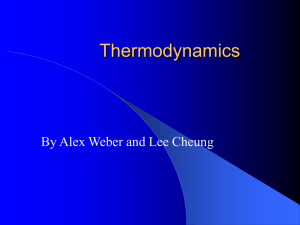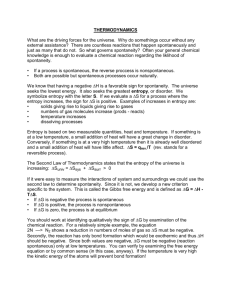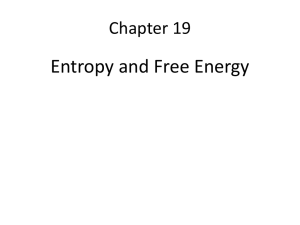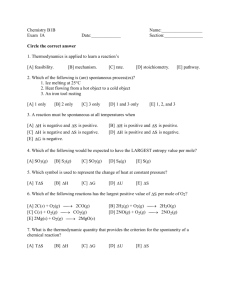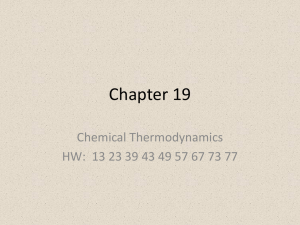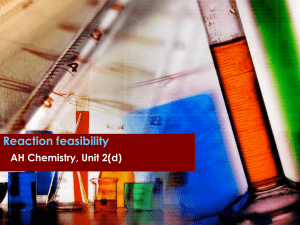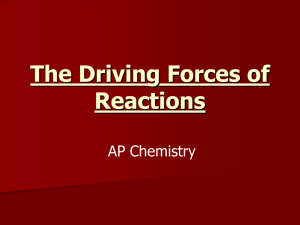Thermodynamics: Spontaneity, Entropy and Free energy
advertisement
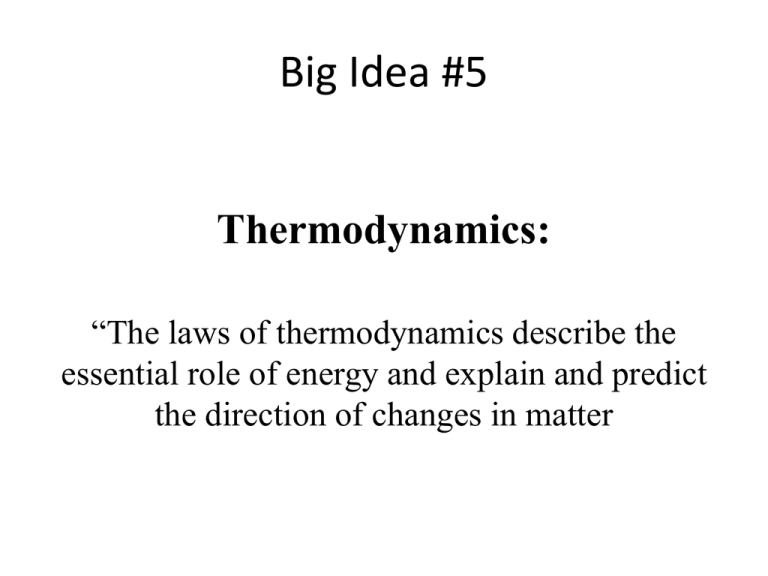
Big Idea #5 Thermodynamics: “The laws of thermodynamics describe the essential role of energy and explain and predict the direction of changes in matter Basic concepts in Big Idea #5 • • • • • • • • • Law of conservation of energy Energy as heat or work Direction of heat transfer (-)(+) Specific heat calculations and calorimetry Hess’s law & applications Ability of energy to perform work (PΔV) Prediction of Spontaneity Gibb’s free energy Gibbs equation (linking temp, enthalpy and entropy) Law of Thermodynamics: • 1st Law: Energy in conserved (neither created nor destroyed in any process) • 2nd Law: the total entropy of the universe increases in any spontaneous process. • 3rd Law: the entropy of a pure crystalline substance at absolute zero is zero (S =0) Thermodynamics: Spontaneity, Entropy and Free energy Definitions: Spontaneous process: a process that can proceed without any outside intervention. (does not describe the rate) Entropy (S)- a measure of the randomness of a system. Enthalpy (H)- the heat flow in a process occurring at constant pressure (no work performed) Free energy (G)- a thermodynamic function that relates entropy and enthalpy to spontaneity. Heat & Specific Heat Capacity When heat is absorbed or lost by a body, the temperature must change as long as the phase (s, g or l) remains constant. q = m ´ C ´ DT q = heat lost or gained (J) m = mass of substance (g) C = the Specific Heat Capacity of a compound T = Tfinal Tinitial is the temperature change ( ºC or K) Calculation and Heating Curve Calorimetry • Relates the energy flow [-q system = +q surrounding] Enthalpy of a Reaction (Calculation of H) H = nHf°products – mHf° reactants where n and m are the stoichiometric coefficients. © 2009, Prentice-Hall, Inc. Thermochemical equation • Relates a reaction to the quantitative amount of energy absorbed (ΔH= +) or released (Δ H = -). • Provides a stoichiometric relationship between a balanced chemical equation and the energy associated with the reaction: Entropy(S) and factors that increase entropy: • Phase change which increased randomness Solid < liquid < Gas • • • • Increase in temperature for any substance. Increase in the number of moles of a gas. Increase in volume of a gas. Formation of a solution from a liquid or solid Calculating entropy changes in a chemical reaction: • Standard molar entropy (S°). ΔS° = nΔS°(product) - mΔS°(reactants) 1. S° elements at 298K are not zero. 2. S° gases> liquids> solids 3. S° generally increase with increasing molar mass 4. S° generally increase with increase number of atoms in the substance. Gibb’s Free Energy: • Describes the “free energy” a system possesses to drive a spontaneous reaction and takes into account both enthalpy (H) and entropy (S) ΔG = Δ H –T Δ S ΔG < 0 spontaneous ΔG > 0 non spontaneous ΔG = 0 equilibrium Calculations for ΔG: • ΔG° = nΔG°(product) - mΔG°(reactants) Standard free energy of formation can be used, just like ΔH° & ΔS ° • ΔG = Δ H –T Δ S ΔH ΔS ΔG - + (- ) Spontaneous + - (+) not spontaneous + + Depends on T (entropy driven) - - Depends on T (enthaply driven Relationship of Free energy and equilibrium (reaction is product or reactant favored) • When a system is at equilibrium Δ G = 0 • We can now use the following equation: ΔG° = -RT lnK (Temp = Kelvin, R = 8.31J/mole K) K ΔG° Reactant/Product favored Spontaneous? K>>1 ΔG° < 0 Product favored Yes K=1 ΔG° = 0 At equilibrium Equilibrium K<< 1 ΔG° > 0 Reactant Favored no




